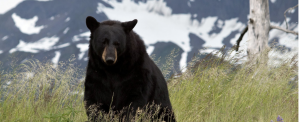Sam Hager
Contributor
[email protected]

Black bear sightings increase in the warmer weather. Students should keep a safe distance from black bears, who, if provoked, can run at 30 MPH.
The coming of springtime marks an influx of life and activity among the wildlife around UNC Asheville, including an increase in bear activity, according to wildlife experts.
“I have bear encounters at least once a month, sometimes once a week,” said Ashley Campbell, accountant and resident of New Haw Creek. Her house is located along what she refers to as a superhighway for bears.
One of the most notable encounters occurred last summer when a young black bear entered her vehicle while she was inside her house.
“The bear opened my car door like a human being,” she said.
Bears can also find their way onto campus, including two who like to come around as the weather grows warmer, according to Assistant Professor of biology Graham Reynolds.
“They’ll wake up, go get food and then they’ll go back to sleep as the weather cools down,” Reynolds said.
If one finds themselves too close to a black bear, they will let you know.
“They will huff and they’ll do a mock charge a lot of times,” Reynolds said.
While such an encounter may seem frightening at first, Reynolds advised students to create noise and keep distance.
“You can literally just yell at the bear,” Reynolds said.
While all bears deserve a respectful amount of space, the likeliest candidates for a frightening encounter are mothers with their cubs in tow, Reynolds said.
“If you see a mother with cubs you want to give them the widest berth,” he said.
Rebecca Hale, an evolutionary biologist with an emphasis on animal behavior at UNCA, referred to the bears that reside around the Asheville area as urban bears. This distinction is made to account for their unique behavior around humans.
“Urban bears are much safer than wild bears because urban bears are used to being around people and they know it’s better to just not mess with them,” Reynolds said.
This familiarity the bears maintain with people should calm students’ fears.
“Encounters with bears should be considered as something exciting instead of scary because urban bears are pretty used to people and know to stay away,” Hale said.
Many other species including a diverse range of insects, birds and small mammals live around campus. With a host of different locations to view and appreciate the wildlife around UNCA, both faculty members urge students to go out and explore.
“Other spots to check out would be in the Pisgah Forest by Pisgah House and at the pollinator gardens,” Hale said.
For specific locations to truly appreciate the wildlife as well as safely see a bear, both biologists suggest Chestnut Ridge.
While bears may not be as much of an issue, other species around Asheville may present a threat. Hale warned students of potential hornet nests around campus.
“In the winter they’re not a problem but come spring the colony will start to grow again, and if you step too close to one they might come out of the ground defensively and sting,” Hale said.
Students should find time to explore all of what UNCA has to offer, Hale said.
“Get out and see what’s around, become familiar with your surroundings and enjoy it while you’re here,” Hale said.

















